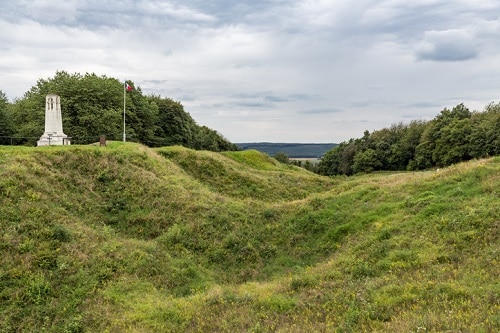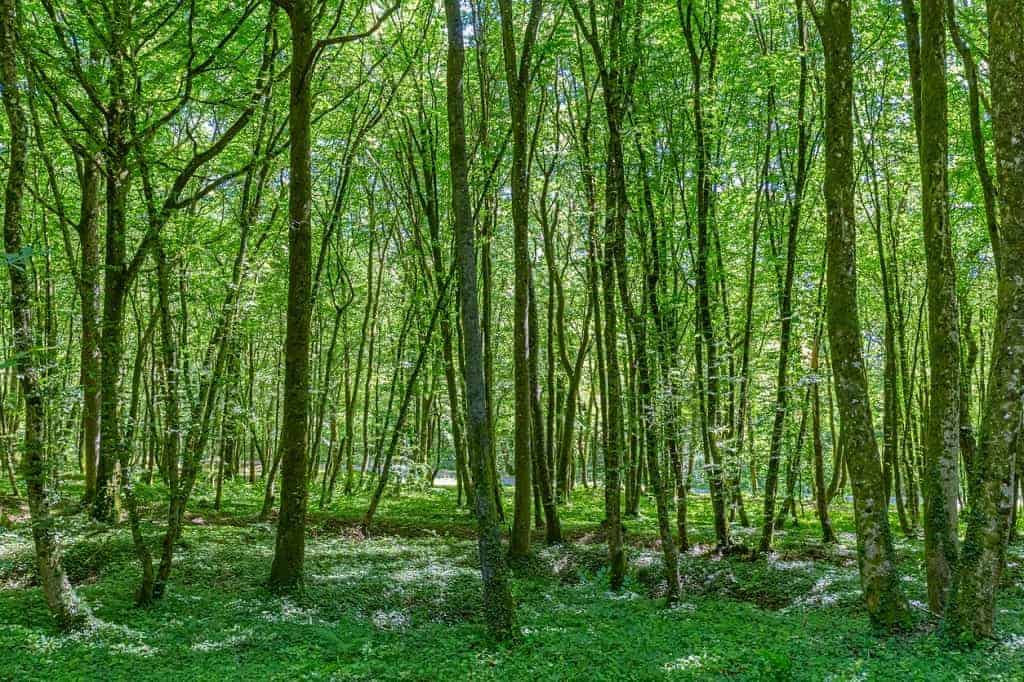There is no escaping the convergence of history and wine in Northeastern France. When you visit a region like Champagne and tour the old, iconic houses and sinuous underground caves that cut the city underneath like swiss cheese, you are learning just as much about the history of the region that was often wrought with conflict and destruction as you are about the bubbly libation that marks momentous celebrations.
For those who want more context behind the bottle, venture out from the vineyards and onto the battlefields for a history lesson, often forgotten, at the site of the longest battle in the First World War.

Just an hour and a half drive from Champagne’s main city of Reims is the bucolic French countryside with wide-open grasslands and forests pockmarked with craters. The craters, now over 100 years old, mark the spots where trenches were dug and mortars fell, causing death and destruction across the land. The current tranquil French countryside surrounding the expansive battlefield of Verdun and other neighboring military campaigns of the region is deceiving, as this part of the world was anything but calm in 1916 when French and American soldiers along with other Allied Forces fought side-by-side against a strong German army.
Now home to monuments and museums, visitors who wish to remember those lost in the long and difficult battles of World War I should make an extra stop during their visit to Champagne and pay their respects to those lives lost on the fields and forests surrounding Verdun.
The Battlefields of Verdun and Visiting the Meuse River Region
It’s important to plan your trip to Verdun and the Meuse region in advance as there are many historical sites to see. When staying in Reims or the region of Champagne, it’s quite easy to see some of the World War I sites in a full or half-day trip by car. The villages surrounding Verdun are small and housing may be difficult to find outside the city, so keep in mind that it may be easiest to stay in Reims or Paris (click here for hotel options) and rent a car to drive about an hour and a half out to the battlefield.
Because the region is quite spread out over the countryside, if you only have a half-day, it’s best to choose sites that are close to each other to maximize your time at each. The impact of each monument and memorial is huge, as the loss of life in this area was massive. It can be quite emotional, and you may spend more time than you think you’ll need visiting each location. Here are a few methods and places to consider on your World War I battlefield history tour.
Take a Guided Day Trip From to the Verdun & Meuse-Argonne Battlefields
This is arguably the most efficient and immersive method for visiting Verdun and all of the other pertinent stops in the region. Our most highly-rated tour includes a well-versed guide that will pick you and up and return you to your hotel in Paris. Alternatively, you can walk the battlefields with a guide on this private tour that includes pickup and drop-off at your hotel in Reims. Typically, these day trips include a visit to Verdun and Meuse-Argonne, the Douaumont Ossuary and Fort of Douaumont, the Romagne War Museum, and the Trench of Bayonets.
Verdun Memorial and Museum
The Verdun Memorial is the most inclusive monument and museum to visit to learn more about the region and its tireless battles. It is located amongst the hills of Verdun and is one of Europe’s leading World War I museums, opening in 1967. It is full of interactive exhibits and information on the war that seemed to never end for the people living in Northeastern France at the time.
Winetraveler Tip: It’s important to note that the museum is closed between December 16th and February 14th, and the opening times vary throughout the year. Check the website for more information on open hours during your visit. Groups of 20 or more must make reservations at least two months in advance, but reservations are not required for smaller groups or single visitors.
Douaumont Ossuary
The Douaumont Ossuary is an incredibly intense memorial that holds the skeletal remains of more than 130,000 unknown soldiers who died during the 300 days and 300 nights of fighting that made up the Battle of Verdun. The Ossuary is the central part of the large monument, and inside there are 22 alcoves that represent the 46 sectors of the battle throughout 1916.
If you walk around the monument and peek into the windows, you can see skulls, femurs, and other bones of the men on both sides who gave their lives during the fighting. Enter the cinema for a 20-minute film on the battle and the creation of the memorial where you sit. The Douaumont Ossuary is an extremely solemn place that will require time spent soaking in the severity of the period in history it represents. This is a must-see site during your battlefield tour.
Fort Douaumont
Since the 1890s, Fort Douaumont was the largest and highest fort out of 19 that protected the city of Verdun. During the Battle of Verdun, it was captured by the Germans early-on in the fighting and recaptured by the French about eight months later. You can visit what is left of the Fort in the Douaumont area near the Ossuary.
Winetraveler Tip: The drive into the Fort is lined with trenches, some of them walk-able, which gives visitors a real-life understanding of what it was like for soldiers defending their land as they protected themselves by digging out earth to hide behind. Off in the distance throughout the forest, you can see the pockmarks left by mortars that fell throughout the fighting. There is a ticket office on site, and you must purchase a ticket to visit the inside of the Fort.
Trench of Bayonets (Tranchée des Baionnettes)
During the battle of Verdun, not only were 300,000 lives lost with countless of them buried as unknown, but several men were buried alive in the battleground, as their bodies were unrecoverable due to the explosive nature of the constant shelling for months and months. One memorial, funded by an American, honors a group of French soldiers who were caught by surprise during fighting that occurred in June of 1916. The third company of the 137th Regiment of French Infantry was almost completely wiped out.
It was not until the battlefield was searched that a neat line of bayonets was discovered attached to rifles sticking out of the completely filled-in trench. The regiment of French soldiers had been buried alive where they stood in their trench. You can visit the trench site, now a memorial located near the ossuary, that honors the men killed in action while defending their land.
Centre Mondial de la Paix
Though it was an architectural feat designed in 1724, since 1994, this archbishop’s palace has been home to the World Peace Center, or Centre Mondial de la Paix. Exhibits within the museum reflect on the issues of peace, freedom, and human rights.
Winetraveler Tip: Different events occur throughout the year, and the museum is open for visitors to enjoy. The exhibition on The Endless War, 1918-1923, is located in the courtyard and is free of charge to visitors.
The Nine Destroyed Villages
Across the landscape of this pastoral region in France, you will find signs recognizing the nine villages that were completely destroyed during the fighting of the Battle of Verdun. These villages still have honorary mayors today as a tribute to their existence.
Winetraveler Tip: Pay attention to the markers along the roads, as you may be traveling through an area that was once home to one of these ghost villages. They are the villages of Beaumont, Bezonvaux, Cumières, Douaumont, Fleury, Haumont, Louvemont, Ornes, and Vaux.
American Cemeteries Honoring World War I Soldiers in the Region
Meuse-Argonne American Cemetery
GPS Coordinates: N49 20.044 E5 05.376
The Meuse-Argonne American Cemetery is the largest American World War I cemetery, and there are more than 14,000 Americans interred here. Despite efforts to recover and identify each body, 450 of those who rest here are unidentified. This cemetery is located 26 miles northwest of the city of Verdun near the small town of Varennes-en-Argonne. When you visit the American cemeteries abroad, the best thing to do first is to stop in the visitor’s center, as there you will meet the American administrator of the cemetery who can give you more information.
Winetraveler Tip: At this site, the visitor’s center building has exhibits, films, and interactive displays to tell the story of the battles during the Meuse-Argonne Offensive. Entrance to the cemetery is free, and reservations are not required. The cemetery is open every day except for December 25th and January 1st.
St. Mihiel American Cemetery
GPS Coordinates: N48 57.419 E5 51.184
Across 40.5 acres, over four thousand American soldiers reside in their final resting place at St. Mihiel American Cemetery on the western edge of Thiaucourt, France. A small chapel and map building make up the memorial at the end of the rows of graves. On the walls of the museum, you’ll find the names of the 284 missing, with rosettes next to the names of those who have since been recovered. The majority of those who rest here died during the St. Mihiel Offensive that threatened Paris.
Oise-Aisne American Cemetery
GPS Coordinates: N49 12.134 E3 32.894
This cemetery is the second largest American World War I cemetery. It was established in 1918 for the fallen during the battles of the Aisne-Marne and Oise-Aisne Offensives. More than 6,000 Americans are interned here, and 600 are unknown. The names of 250 Americans who are missing and perished in the region are listed on the Walls of the Missing in Chapel. It is located about a mile East of Fère-en-Tardenois, which is 14 miles northeast of Chateau-Thierry, and a 45 minute drive west of Reims.
Somme American Cemetery
GPS Coordinates: N49 59.103 E3 12.798
Located about an hour and a half northwest of Reims and a half-mile southwest of the village of Bony (Aisne), France, the Somme American Cemetery is home to the graves of 1900 Americans with 300 names engraved on the Walls of the Missing within the chapel. It is named for the Somme region in France and was first established as a temporary battlefield cemetery in 1918. Throughout the years, as remains are identified, rosettes are placed next to the names of the missing to indicate that they have been found.
For more information on American monuments and cemeteries abroad, visit the American Battle Monuments Commission website.
Frequently Asked Questions About Visiting the Verdun Battlefield Near Champagne
More Ways To Explore France
Essential Things To Do in Paris
See All Travel Guides To Visiting France

My grandfather fought in the Battle of Verdun. Thank you for this-I’ll definitely visit the memorials when I’m in the area.
Thank you for your comment. I’m glad you enjoyed the article. The memorials are definitely worth visiting!